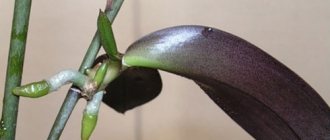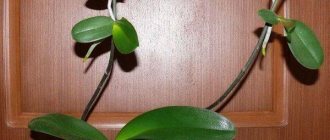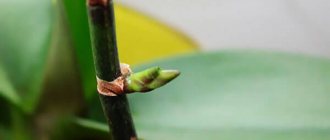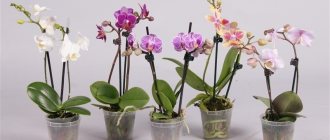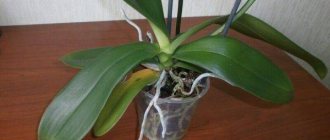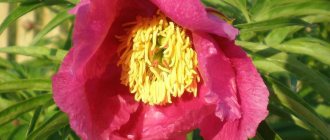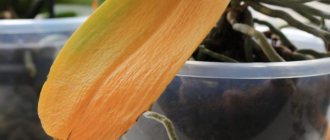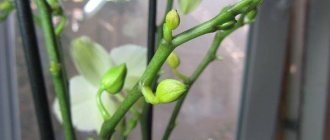general information
An orchid's peduncle is a shoot on which flowers form . There can be more than 50 buds on one peduncle! But this is for an adult and large orchid. The peduncle looks like a long and flexible stem, on which subsequently, after it has grown to a certain length, orchid buds will begin to bloom. Some gardeners use the term “peduncle” in a narrower sense and understand it as the area of the stem part of the plant on which the flowers are located.
ATTENTION : Peduncles can grow in the most bizarre ways, both straight and bending in all directions. Sometimes they bend like a pig's tail, twisting into rings.
The main rule is that the peduncle always grows from the growing point. Read more about the appearance and development of the peduncle here.
Step-by-step instructions on how to get a smooth escape
To get a smooth escape, you need to determine whether it is really an arrow. If this is her, then the following measures should be taken:
- The flower should be tied vertically as soon as it reaches a height of 20 cm.
- The arrow should be tied to a support. To do this, you can use a special clothespin or rubber band.
- If you can’t tie the peduncle, you can correct the situation by turning the pot over. The arrow will always be drawn towards the light and straighten on its own.
There are situations when the peduncle grows for a long time. To ensure that the arrow does not freeze in development and does not slow down its growth, the following rules must be followed:
- Provide adequate lighting. If necessary, introduce additional lighting using special lamps. This will make the orchid’s peduncle appear faster.
- Watering must be reduced, but you should not overdry the flower either.
- Maintain the required temperature conditions.
- Apply missing fertilizers in a timely manner. This will help force the phalaenopsis to release the arrow.
An orchid, due to its biological structure, cannot produce more than 3 flower stalks. Usually the plant has one shoot on which flowers bloom. But if the plant is already mature and has about 10 leaves in its rosette, then 2 or 3 flower stalks may appear.
Note.
Abundant flowering in phalaenopsis can cause stress for the plant. After flowering, an orchid often begins to experience a “loss of strength” and the flower may die.
Why is it important to determine what new shoots a plant has?
Whatever happens to an orchid is always a joy for a gardener who loves his plant. A new root, baby or peduncle that promises lush flowering is equally good. But it is still worth distinguishing the peduncle from other parts .
This way you will understand that the plant needs to be cared for more carefully. After all, during the flowering period, an orchid requires special attention and periodic feeding. The watering schedule also changes.- It is not always a good idea to let a plant bloom. If it is not healthy, or has just undergone a difficult transplant (for example, due to rotten roots), the best solution would be to cut off the peduncle to give it strength to grow directly.
- No one canceled simple interest. And an orchid, as you know, is a leisurely flower, and it will take a long time to grow an incomprehensible shoot.
What does he look like?
Throughout its life cycle, the peduncle changes greatly. It can be of two types.
New
It usually grows from the leaf axil - the place where the leaf comes close to the stem. It breaks through the leaf. The peduncle is usually flat in shape, but has a pointed tip that has a stepped shape . It is light green or rich green in color, growing upward or sideways, heading towards the sun.
IMPORTANT : You can immediately see the scales on the peduncle. From the beginning of the growth of the peduncle to the opening of the first buds on it, it usually takes about a couple of months, so be patient.
Old
Gradually, the hatched peduncle will grow, turning into a long flexible stem, juicy and green. Then the buds will bloom on it. Orchid flower stalks are very fragile and easy to break . So it is better to tie the peduncle as it grows.
When the orchid fades, the peduncle will begin to change: it will change color to yellow or brown. Sometimes the color may even change to red or bright purple. After this, the old peduncle dries out and falls off. But it’s better not to let it get to this point, and cut off the peduncle immediately after the last flower has withered - this way you will save the plant’s strength.
But sometimes it is difficult to understand whether the flowering period has already ended . Pay attention to the tip of the peduncle. While it is green, this means that it is growing, it can increase in size and produce new buds. But if the tip turns yellow, blackened or dried out, flowering has come to an end.
Whether or not to trim the peduncle can be decided individually. The fact is that the old peduncle can bloom again or form a baby. On the other hand, old flower stalks inhibit the development of new ones and generally weaken the plant. We discussed the issue of caring for a faded orchid in more detail here.
How to distinguish from the root?
A recently hatched peduncle can easily be confused with a root or baby. Focus on these differences:
Peduncle:- Appears strictly from the neck of one of the freshly formed leaves.
- The tip is sharp and has a complex, stepped, cone-like shape.
- The shape of the tip is somewhat reminiscent of a closed beak.
- The shape of the peduncle itself is something flattened, rather flat.
- It stretches upward, less often sideways. The peduncle will fall down later, under the weight of the formed buds, if it is not tied up in time.
- Root:
- It often grows outside rather than in the leaf axils. It can grow from anywhere on the orchid neck, including from the middle of the leaf.
- The tip is bright, and then there is a light velamen.
- The shape of the tip is round, smooth, without scales.
- The shape of the bud is evenly rounded and cone-shaped.
- It can grow in any direction: up, sideways, but more often it tends downwards.
Watch a video about the difference between a peduncle and an orchid root:
Differences between aerial roots
How to distinguish an aerial root from a peduncle? First of all, it should be noted that aerial roots are no different from those under the bark layer. The only thing is their color. Those that have full access to light will have a bright light green color, while those that are inside the container will have a yellow-brown tint.
The functions of both types are the same - to feed the plant with nutrients and participate in the process of photosynthesis. And the difference between a flower shoot is written above.
How is a peduncle different from a baby?
What does the baby look like:
- It grows in the place of the peduncle, next to the central vein of the leaf.
- The shape of the tip is similar to an open beak.
- Pointed upward.
It is almost impossible to distinguish a peduncle from a baby . You need to wait until the process increases to at least 3 cm, then it will be possible to understand something from the shape of the tip. The ability to instantly recognize what exactly your orchid is growing comes with experience.
Watch a video about the difference between a baby and an orchid peduncle:
How to care?
After releasing a peduncle, the orchid can bloom for up to a year, gradually increasing it and opening bud after bud. In another scenario, many flowers will open on the orchid at the same time, which will soon wither.
You can prolong flowering by properly caring for an orchid with a peduncle.:
Do not allow the peduncle to remain in a draft. Both cold and warm air flow are equally destructive for him, so keep him away from the radiator and air conditioner. An orchid that has stood in a draft for a day can lose all its flowers.- Once you have determined that it is a peduncle and not a baby or a root, forget about replanting for a while. While flowering is in progress, you cannot touch the orchid. This is especially true for phalaenopsis, which is capricious in terms of transplantation.
- Secure the peduncle to a special holder, or tie it up in some way.
Of course, in nature no one ties up the flower stalks, and they fall down in a spectacular cascade. But at home, a loose peduncle can be easily damaged. Especially if you have pets who are always ready to try something new. TIP : A reliable fastening can be a plastic or wooden support, to which the peduncle is attached with a special clamp. You can simply tie it with thin satin ribbons or strong threads - it’s even more aesthetically pleasing. Do not tighten the thread too tightly so that it does not cut the succulent peduncle. - Provide the flower stalk with sufficient lighting. If there is not enough natural light, add additional lighting. Otherwise, it will reach towards the light, grow behind it, and you will get a spiral instead of an even arrow. In addition, only with full lighting will the peduncle develop normally: the more light, the faster it grows.
- It is necessary to water the orchid during the growth of the peduncle according to the same scheme. But with the beginning of flowering, reduce watering.
- If you fed the orchid, then continue feeding until the first flower forms.
- If after flowering the peduncle begins to dry out quickly, cut it off with sharp scissors. You need to leave a small “stump”. Sprinkle the cut area for disinfection with crushed charcoal or ground cinnamon. The remaining stump will be hollow inside. If water begins to stagnate in it, this will lead to rotting of the trunk. It is better to immediately seal the hole hermetically, for example with beeswax.
- If the peduncle remains green, do not rush to cut it off. Or trim the peduncle just above the third node - this will stimulate re-blooming. But it is better not to use this advice if the plant is still young - it does not have enough strength for a baby or a new flowering.
Watch a video about caring for an orchid with a peduncle:
Features of care
Whether the phalaenopsis will bloom or will delight you only with green foliage depends on the care provided.
For proper and abundant flowering you need:
- Sufficient lighting if the orchid has released a peduncle. During the dormant period, namely in autumn or winter, the plant will have enough natural light from the window. The only condition is that the window must face south. In other cases, additional lighting with a phytolamp is necessary. Daylight hours for a phalaenopsis that has developed a shoot should be at least 12 hours.
- When an orchid's peduncle appears, optimal humidity is important. During flowering, phalaenopsis needs moisture. In an apartment with central heating it is not enough. For these purposes, it is recommended to use a humidifier. Watering is carried out as the soil in the pot dries.
Orchid care is divided into 2 periods. For an orchid to shoot an arrow:
- Diffuse lighting is required. From the beginning of April, the flower must be removed from the window to protect it from sunburn.
- Provide a supply of fresh air (avoid drafts).
- Keep the humidity level within 80%.
- Fertilizing should be done with fertilizers labeled “For orchids.” Others may harm the plant.
During the growth period of the peduncle:
- Reduce the watering regime as soon as the shoot begins to develop. The orchid needs to be watered once every 5 days.
- Features of the influence of fertilizing on the flower arrow. With the appearance of flowering shoots, fertilizing should be reduced. And when the buds form, stop altogether. Fertilizing can shorten the flowering period.
- Lighting and temperature. When forming an arrow in autumn or winter, the flower should be placed on a window on the south side. If this is not possible, then additional lighting should be created. Without proper lighting, the shoot will not be able to develop.
Note.
The temperature to grow a peduncle should be about 25C. When the temperature drops, the plant may dry out. The number of buds is influenced by previous care, and not by spring fertilizers.
So, what can you do to make more arrows hatch? In phalaenopsis, the stem is formed in 2 months. During this period, development occurs from a small stem to the formation of a peduncle. The period of growth of a new peduncle depends on environmental conditions. If the plant is provided with all the necessary conditions, the growth process can accelerate. The side shoot on the orchid develops faster, expelling the buds. The emerging flower stalks on the orchid open gradually. In 1 year there may be 2 or 3 flowering periods. They last about 2-3 months. If the flowers fall earlier, this indicates a lack of moisture or light.
Stores usually sell phalaenopsis with 2 or 3 branches. The number of arrows depends on the type of flower and environmental conditions; during the flowering process, it can throw out more arrows.
